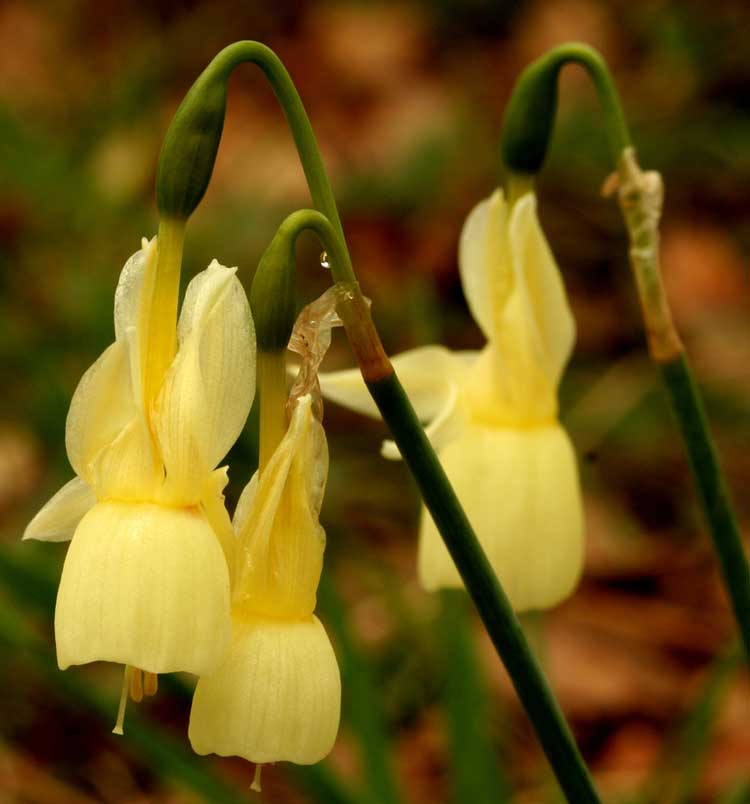
Narcissus triandrus (*)
Classification System: APG IV
Superregnum: Eukaryota
Regnum: Plantae
Cladus: Angiosperms
Cladus: Monocots
Ordo: Asparagales
Familia: Amaryllidaceae
Subfamilia: Amaryllidoideae
Tribus: Narcisseae
Genus: Narcissus
Subgenus: N. subg. Narcissus
Sectio: N. sect. Ganymedes
Species: Narcissus triandrus
Subspecies: N. t. subsp. lusitanicus – N. t. subsp. pallidulus – N. t. subsp. triandrus
Name
Narcissus triandrus L., Sp. Pl. ed. 2: 416 (1762).
Synonyms
Homotypic
Ganymedes triandrus (L.) Haw., Suppl. Pl. Succ. 130 (1819).
Illus triandrus (L.) Haw., Monogr. Narcissin. 4 (1831).
Queltia triandra (L.) M.Roem., Fam. Nat. Syn. Monogr. 4: 203 (1847).
Distribution
Native distribution areas:
Continental: Europe
Regional: Southwestern Europe
France, Portugal, Spain.
References: Brummitt, R.K. 2001. TDWG – World Geographical Scheme for Recording Plant Distributions, 2nd Edition
References
Linnaeus, C. 1762. Species Plantarum, ed. 2, Tomus I: 416. Reference page.
Links
Govaerts, R. et al. 2018. Narcissus triandrus in World Checklist of Selected Plant Families. The Board of Trustees of the Royal Botanic Gardens, Kew. Published online. Accessed: 2018 Aug. 06. Reference page.
International Plant Names Index. 2018. Narcissus triandrus. Published online. Accessed: Aug. 06 2018.
USDA, ARS, Germplasm Resources Information Network. Narcissus triandrus in the Germplasm Resources Information Network (GRIN), U.S. Department of Agriculture Agricultural Research Service. Accessed: 07-Oct-06.
Narcissus triandrus is founded from a subspecies of the Narcissus, perhaps more commonly known as the Daffodil. While the mother taxa of Narcissus is native to colder weather climates such as the British Isles, the Narcissus triandrus finds itself native to France, Spain, and Portugal.[1] This plant was given the more memorable name of Angel's Tears because of the flowers' downward-cast bud.[2]
Taxonomy[1]
Taxon Name: Narcissus triandrus L.
Kingdom: Plantae
Phylum: Tracheophyta
Class: Liliopsida
Order: Asparagales
Family: Amaryllidaceae
General Anatomy
Anatomy of this plant is very similar to that of other plants, the general few being roots, bulbs, leaves, stems, and flowers. The roots of these plants are few and thin, spreading away from the bulb but not venturing very far.[2] The bulbs are hardy and lay dormant about a foot down in the soil for the majority of the year until the plant beings to flower again in the spring. This plant, similar to the daffodil, has two to four broad, wide, semi-cylindrical leaves.[2] The stems are thick and tubular, almost waxy on their outer side.[2] Each plant contains one stem of which the leaves and three to five flowers buds.[2] This plant is also a type of inflorescence plant, the true flowers of the Narcissus triandrus L. resting inside the cup.[3] The cup itself being about a half inch long and pale. It's shape resembles something globular as the opening of the cup is rounded inwards.[2]
Female Anatomy
Contained within the flower are the stigma, the style, and the ovary. Flowers from this plant are usually concolorous, being of the light yellow or pale white shade, and usually lighter than the perianth segments.[2] Said perianth is reflexed with a slender tube and consists of around six segments all of which are also yellow or white (these being the most gene-pool flooding colors.) and get to be about one to three inches in length.[2] The stigma which receive pollen from various pollinators, rests at the end of the pistil facing towards the ground.[4] The ovaries are also sharply turned, however they face away from the pedicel.[2]
Male Anatomy
Male organs of this plant consist of the anther and the filament.
Reproduction
Several studies have been done on this plant in relation to how it reproduces. Self vs cross pollination was tested and it was shown that self-pollination resulted in a lower seed count.[5] This meant that self-sterility was present in the plant, but was conducted prezygotically and did not involve any incompatible systems.[5] This result was caused by embryo sac degeneration, an affect of low ovary availability.[5]
Planting
While not a very popular subspecies of the Daffodil, these plants have similar care and blooming needs.[6] They are low maintenance plants that require full sun, or part shade, medium water (meaning that the soil should be watered until damp, then left to dry and once dry, watered lightly again).[6] And if wanted to be placed in a garden, these hardy little buds will be tolerant of rabbits, deer, and drought.[6] This aversion towards disease and pests is known to be from the plant's high alkaloid and lycorine content.[7]
Flowering in late spring, April through May, it is best that these plants are planted above summer blooming buds, yet below early spring bloomers.[7] It is suggested that these plants be potted or placed in soft, well drained ground in late fall.[6] If planted deep enough (two to three times deeper than the bulbs original length) then it should retain its moisture and last through the winter.[6] And, while these flowers do like shady areas, it is better for them to be placed in full sun or in an area that gets sun throughout most of the day, this is because of the flowers of like to point towards and be in the sun's light as much as possible.[6]
Distribution and Habitat
Native to Spain and Portugal, this plant prefers lower pH level soils. It has been observed to grow in scrublands, mesophilic grasslands, sandy soils, including some more rocky areas. In Europe, the plant has been spotted in the Iberian peninsula, the Iberian and Aracena Mountains, as well as the Baetic and Penibaetic mountain systems and the Serra de Monchique.[1]
Retrieved from "http://en.wikipedia.org/"
All text is available under the terms of the GNU Free Documentation License

